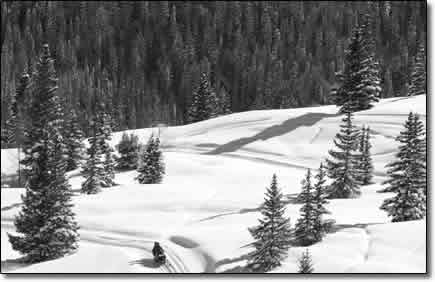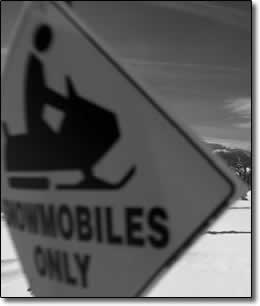|
Forest Service seeks common ground in escalating situation

|
|
A snowmobiler takes a tour on Molas Pass last weekend. As recreational use, among snowmobilers and skiers, increases, local land management agencies are looking for ways to reconcile the two, which are frequently at odds./Photo by Jared Boyd.
|
by Will Sands
A line is being drawn in the snow of the San Juan National Forest. Skiers and snowmobiles
seem to be increasingly at odds in the local backcountry. Two separate petitions are currently circulating locally,
calling for areas to be designated off limits to motorized uses. Meanwhile, the Forest Service is continuing to work
to address what it considers its biggest challenge: reconciling conflicts between motorized and nonmotorized uses.
"It overwhelmed the entire drainage," said Rose Chilcoat of a recent encounter with a snowmobile while out on a
cross-country ski. Chilcoat, who is the program director for the Durango-based Great Old Broads for Wilderness,
further explained, "As a skier, there is something very threatening about a large and relatively anonymous vehicle
coming at you at high speed. A person on skis feels assaulted. You don't feel safe, especially if you're alone."
Chilcoat said that in her own experience, this kind of incident is becoming more common in the San Juan National
Forest. In particular, she said that many of her favorite locales for skiing have started to become snowmobile
playgrounds. "I'm really sad at the loss of places where one can escape vehicles in any season and any terrain," she
said. "It seems the motors are winning."
This sentiment has kicked off two separate petition efforts in different areas of the San Juan Mountains. One of
these is now more than 850 signatures strong. It calls on the Forest Service to enhance the skiing and snowshoeing
experience on Molas Pass by expanding the 200 acres at Andrews Lake now designated as nonmotorized, an area
affectionately called "the donut hole."
Durango resident Joe Griffith initiated the petition in hopes of giving a louder voice to cross-country skiers and
snowshoers. "From a nonmotorized user perspective, there's not enough space at Molas Pass," he said. "If you go up
there and ski, you realize it's a tiny area and totally inadequate."
Griffith added that to compound the problem, the number of users is expanding on both sides of the recreation coin.
In addition, the climate appears to be warming, making areas like Molas Pass more and more precious.
"The number of motorized users has expanded quite a bit, and the weather has gotten warmer and warmer," Griffith
said. "The high snow is the only snow that's lasting anymore."
Griffith said that 850 signatures should send a strong message to the Forest Service. "We think we've got a strong
case," he said. "We're currently planning our next step. We're trying to figure out if it's enough to fold this into
the current forest plan revision or if we need to take action beyond that."
Another similar effort is under way not far from Molas Pass. Spearheaded by the Ouray Trails Group, a petition is
seeking to designate a large portion of the Red Mountain Pass area as off-limits to snowmobiles. The petition cites
that the area has not been historically popular with snowmobile users; has a tradition of winter usage by skiers,
snowshoers and snowboarders; has a history of field education by the Silverton Avalanche School and the American
Avalanche Institute; and the area is environmentally and historically sensitive, among other things.Richard Speegle,
recreation project leader for the San Juan Public Lands Center, commented that the agency is not surprised by the
petitions. He said that the Forest Service is increasingly dealing with user conflicts between motorized and
nonmotorized groups.
"We've had several nonmotorized groups indicate that they'd like to see several more areas made off-limits to
snowmobiling," he said. "And it's becoming a safety conflict more than just an aesthetic conflict. We see both as
viable uses of public lands, but there's increasing competition for space."
Speegle said that motorized use during both winter and summer months is growing dramatically on the San Juan National
Forest. In fact, it's grown to the point where it's become the lead concern in the ongoing revision of the Forest
Plan.
"Based on the volume of use, there have been more and more conflicts," Speegle said. "This is the biggest issue in
our forest plan. We're at the junction of how do we address the increase in use, and it's not just snowmobiles. There
are also more skiers and snowshoers out there."
According to Speegle, the Forest Service is stuck in the difficult middle position. "We're in the middle trying to
get everyone to share the sandbox," he said.

|
|
A "snowmobiles only" sign marks terrain near Molas Pass. Richard Speegle, with the San Juan Public Lands Center, said motorized use in the San Juan National Forest is growing dramatically./Photo by Jared Boyd.
|
According to Speegle, the Forest Service is stuck in the difficult middle position. "We're in the middle trying to
get everyone to share the sandbox," he said.
One group that actually appears to be willing to share the sandbox is the snowmobile community. Charlie Cox,
president of the Colorado Snowmobile Association, said that his group has worked closely with the Forest Service over
several decades to accommodate both motorized and nonmotorized users.
"We have worked hard for 35 years with the Forest Service and Colorado State Parks to develop and groom trail systems
throughout the state," he said. "We do that for all trail users, not just snowmobilers."
Cox said that the request that areas be designated nonmotorized flies in the face of multiple use. "Snowmobiles are a
legal recreational use of the forest, and we expect to be able to exercise that use," he said.
He added that this should be especially true in the case of Molas Pass, where designated wilderness, a place where
motorized uses are absolutely prohibited, is not far from the highway.
"There is a wilderness area down there that is close to the highway and is already designated nonmotorized," he said.
"All they have to do is develop a trail system there. We've already developed ours on Molas."
Roger Pennington is the president of the local snowmobile club, the San Juan Sledders, and vice-president of the
Colorado Snowmobile Association. He said, without a doubt, snowmobiling is growing both locally and nationally. "The
sport is constantly growing," Pennington said. "Anybody can do it. You can be young, old or handicapped. It allows
anybody and everybody to get into the backcountry."
In spite of this growth, Pennington said that the conflicts seem to be the same as ever, and he put the blame on a
few bad apples.
"I don't think it's any worse than it ever has been," he said. "The people who pass you on the double yellow on the
highway are going to do the same thing in the backcountry, whether they're on a snowmobile, skis, a bike or in hiking
boots. There are just some people with the 'me first' attitude."
In contrast, Pennington said that the San Juan Sledders respect all backcountry uses and try to encourage cooperation
in the backcountry.
"To me, other recreational users are not the enemy," he said. "We groom trails for multiple winter use, and that's
what we advocate. We all pay taxes, and we're welcome to go out and recreate in the manner we see fit."
Whether cross-country skiers in search of solitude can co-exist with the noise, smell and speed of snowmobiles will
be tested in part by the current San Juan National Forest Plan revision. The plan is being revamped after 20 years,
and as Speegle explained, motorized vs. nonmotorized issues are getting most of the air time. He encouraged people on
both sides of the issue to bring their concerns to the table now and create an amicable situation for the coming 20
years.
"I think there are changes that need to be made on both sides," Speegle said in closing. "Now is the time for public
involvement for making those changes. We're trying to listen to everybody first and then hopefully solve some of
these problems."
For more information on the San Juan National Forest Plan revision log onto http://www.ocs.fortlewis.edu/forestplan .
|